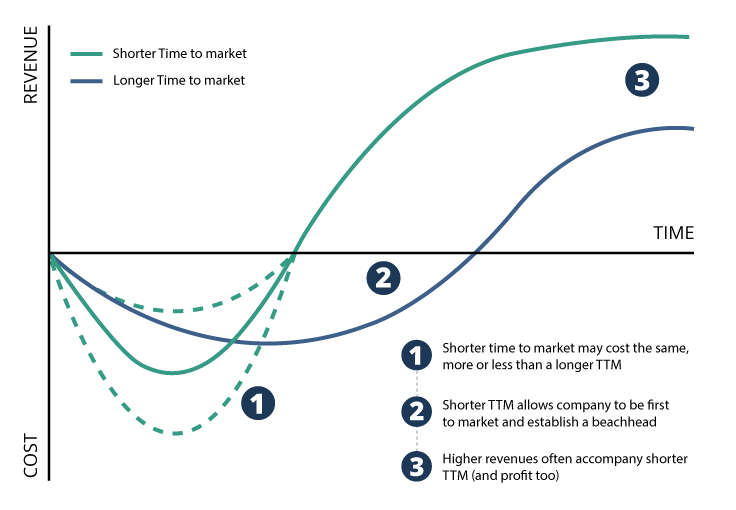What is Time to Market (TTM)?
Time to market (TTM) describes how long it takes to develop a product from conception until it is released to the market and available for sale.
Why It Is Important
Time to market is essential because it allows you to get to the market before competitors and increases sales, profit, and market share.
Since research has shown that new market entrants enjoy clear market share, revenue, sales growth, and overall competitive advantage, time to market within the product development cycle is one of the essential product development key performance indicators (KPIs) or metrics. Many product development strategies depend on being first to market.
Time to market is both quantitative and qualitative. There is the best amount of time for a product launch, which is not always as soon as possible, although, with more innovative offerings, it usually is. Releasing at the right time requires adaptability, learning quickly, and resilience. These capabilities are at the forefront of time-based competition today.
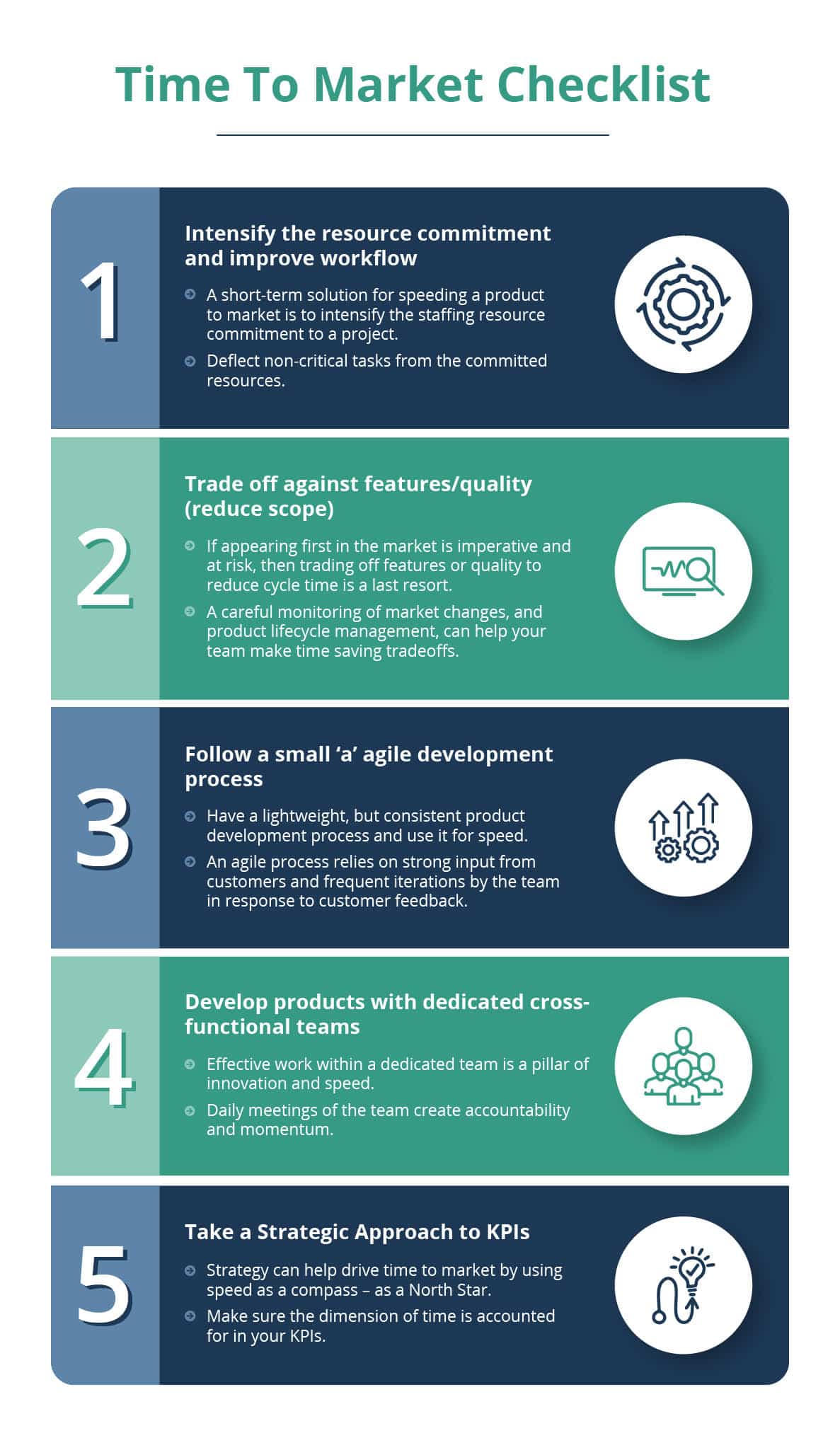
Why Do Companies Want to Reduce Time to Market?
Competitive pressures, dynamic information, and new technologies commonly drive market changes. Companies must respond to these changes. It is often the first to field a new product or initial idea that captures market share and profits.
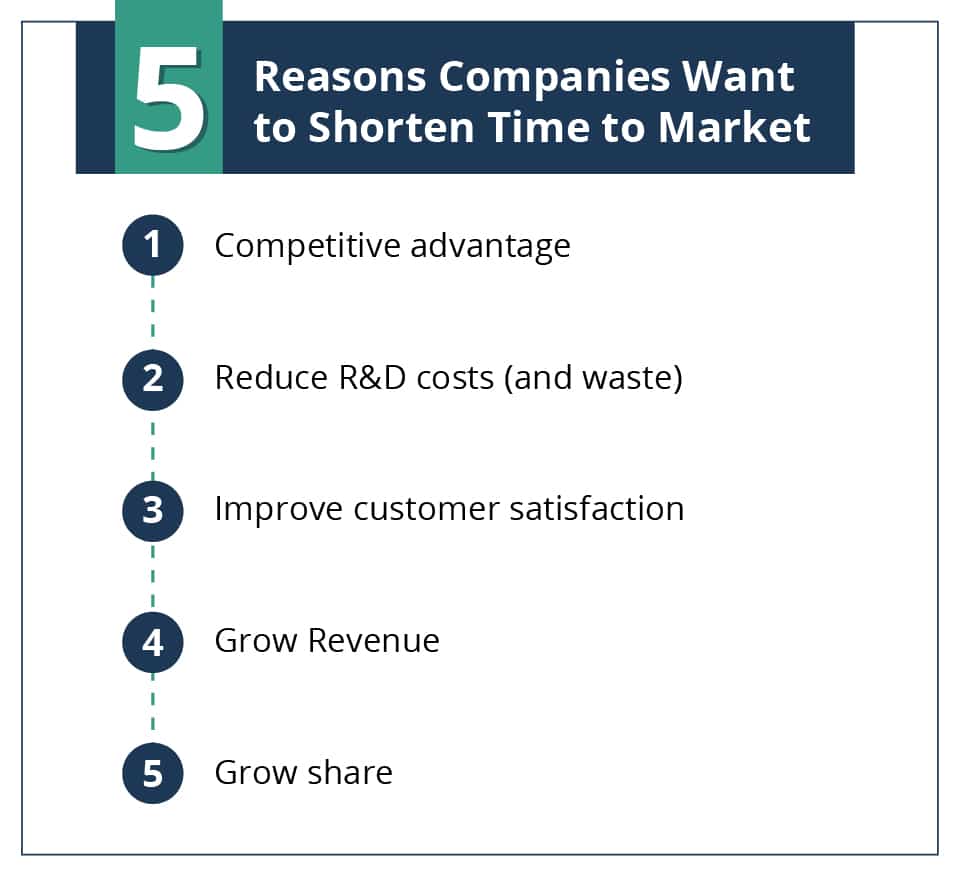
Customers’ insatiable desire for the newest features, meeting corporate growth objectives, shorter life cycles, and pressure from senior management also drive speed to market. For many consumers, the incredible rate of innovation in mobile handset devices, fueled by constant ideation of new features, has set the expectations for a continuous set of improved features on a yearly cadence.
Companies also lose financially when they don’t meet their time-to-market targets. In a classic study, McKinsey & Co. found that a product six months late to market earns 33% less profit over five years; if it is released on time but is 50% over budget, that cuts profits by only about 4%.
Some tech leaders focus on speed as the ultimate goal, such as Facebook’s declaration, “Move fast and break things.” Others may focus on time to market because they face pressure from direct competitors. Yearly shows and insatiable consumer expectations drive tech companies and mobile handset providers.
Technology companies in the B2C software development industry often use and succeed with the concept of a minimum viable product (MVP). Although this approach takes some risk with customer satisfaction, it also enables the team to move very quickly and reduce time to market by shipping a version with core features only.
Those that use time to market strategically demonstrate what they’re trying to create by shaping their product portfolio. Is it a platform that entails a long-term investment or a quick spin? Is it innovative or a ‘me too’ offering?
Timing releases are a means of competitive differentiation. Adapting and learning quickly is critical for the strategic project management of release timing and faster time to market. Product management consulting by an outside party can provide an independent perspective on the value of speed to market for product differentiation.
The TTM Advantage
The most crucial reason that time-to-market matters is that it is fundamental to competitive advantage. You can take advantage of business opportunities by improving TTM to beat your direct competitors to market quickly. By optimizing your development process and your marketing KPIs and process to improve time to market, you gain a “first mover advantage.” When your company’s product development process is fast, your company is first to market aligned with a strong market strategy, and the product launch has more impact, resulting in more outstanding sales and profit margins than your slower competitors.
What are the KPIs used to measure Time to Market?
Time to market measures the time on the calendar (months or years) it takes to bring a concept to market. Typically, a KPI for TTM is simply the period (in weeks or months) from team start to first customer ship, but larger companies may start with budget approval and end with the first customer ship.
Some firms start the clock after the team and budget go through the approval process, but an informal team might do much work before this time, let’s say, doing an initial product design (very high level). In other cases, the project is approved, but weeks might elapse before the team members are freed up to concentrate on the project in a dedicated manner. Define when the project begins and ends as precisely as you can.
Recommended Time to Market Measurements
- The ‘clock is started’ when the team is available, and there is an initial definition (and significant risks retired)
- The ‘clock is stopped’ when either a MVP or the first version of the product is sold (or adopted), often after product launch
However, comparing TTM between teams or organizations requires some care to ensure an ‘apples to apples’ comparison. The most significant factor influencing time-to-market is the project’s scope and risk; the second most influential factor is how much product innovation is needed to differentiate the product from the competition. Time-to-market comparisons and marketing KPIs aren’t accurate unless you clearly understand when the stopwatch starts and stops and the scope/risk profile between two development projects.
What are typical TTMs across companies?
Time to market varies widely by what is sold: product type, complexity, and industry. A typical time to market for a pharmaceutical is ten years. At the same time, a consumer social app could be conceptualized, researched through market research, designed, prototyped, and launched in less than a year. Fundamentally, TTM varies based on product and regulatory complexity.
There is considerable variation in time to market, even within the same industry, due to the complexity and architectures of various products. An utterly novel platform with untested technology takes longer to create than a significant improvement on an existing offering (i.e., a derivative) or an incremental improvement. Launching products that quickly reach the market depends on product complexities, related alternatives, and industry benchmarks.
Consider the research from the automotive industry. Research from 2017-18 found the following spread from time to market in that industry. The study showed that 71% of products in the sample went from concept to launch in less than two years. The automotive products in the study are divided into the following buckets concerning time to market. Note that the longer times were most likely for major clean sheet platforms and variants (derivatives).
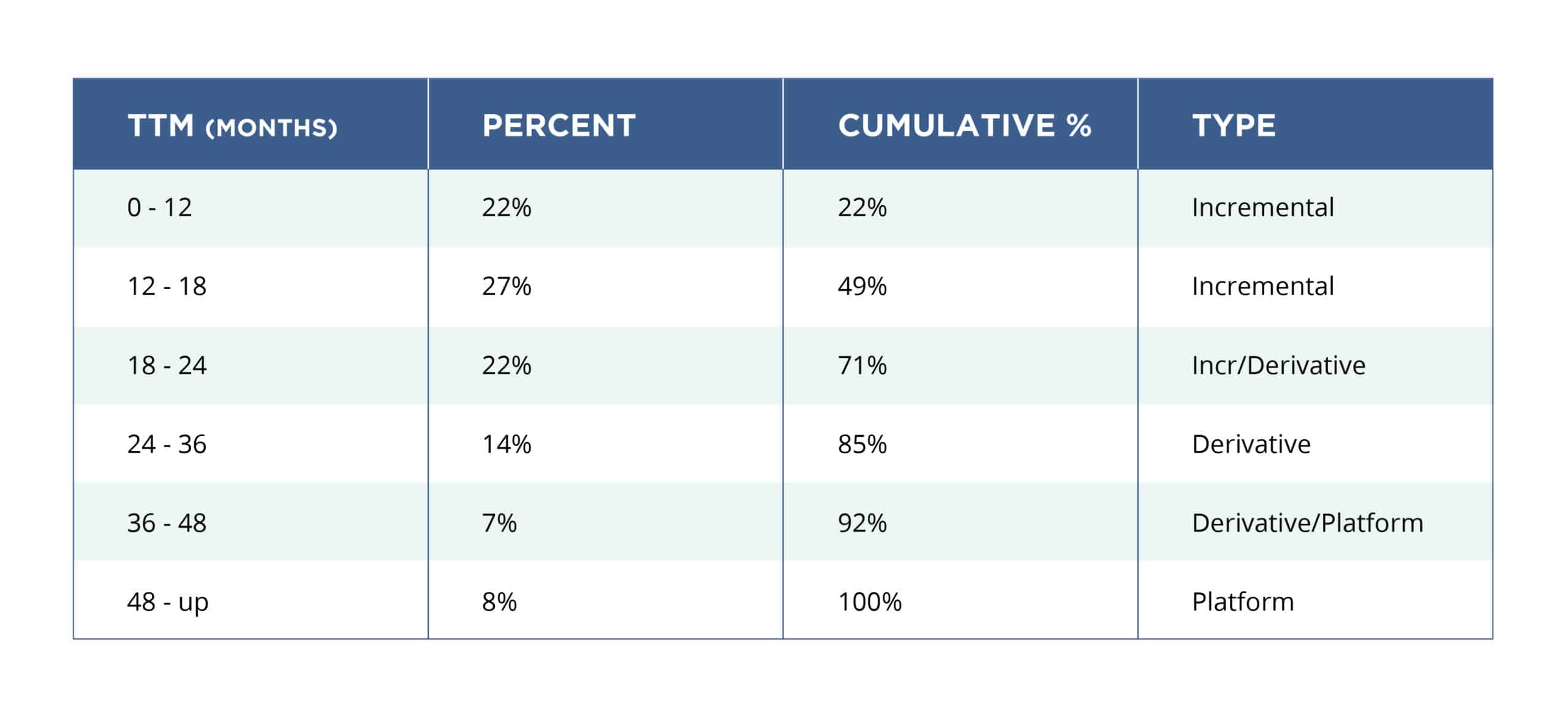
Despite the wide variance in time to market even for existing products in the same industry, KPMG research (2015) found the following typical ranges for time to market by industry.
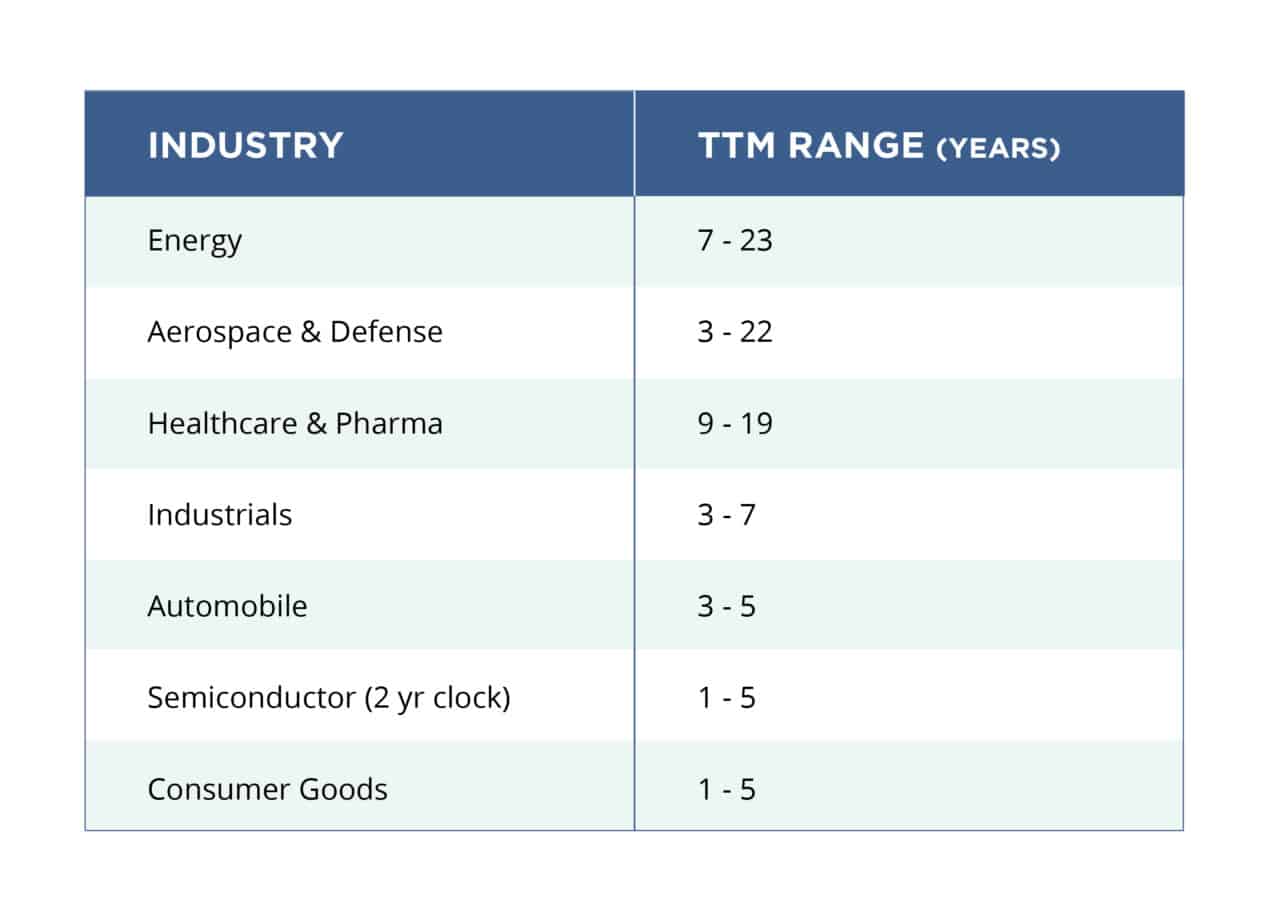
How can Time To Market be Used Strategically?
Time to market is an essential facet of product development strategy. Generally, speed is balanced against other factors such as features, innovation, or product quality. The interactions between these factors spell success or failure due to the nature of the product and the market. A fast time to market doesn’t always equal success if the elements require more development.
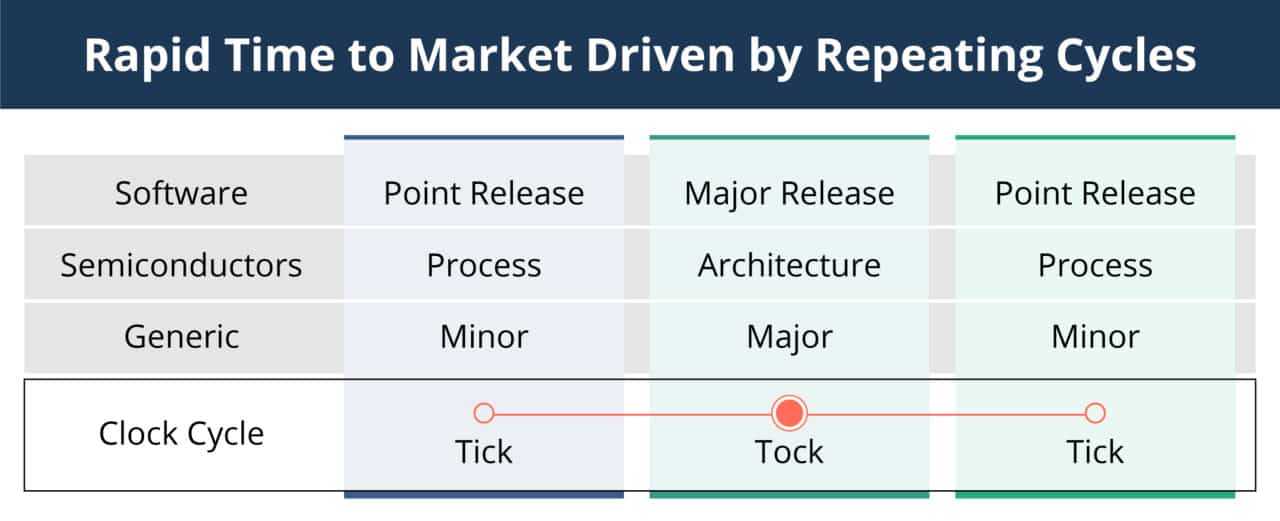
Semiconductor example: pattern of alternating major and minor releases (‘tick/tock’)
One crucial way to drive TTM speed and predictability is to break your release cycles into major and minor releases. Semiconductor firms like Intel and AMD typically have a ‘tick tock’ release cycle, meaning one major release (‘tick’) followed by one minor release (‘tock’). This approach gives a project for a significant release a two-year path to market, mitigating the risks for these innovative products.
In the case of mobile handsets, makers like Apple have supercycles every three years. Each year between the major releases is dedicated to “themes” such as bug fixes (year one) and performance enhancements (year two).
However, suppose you are not in a ‘platform’ business like Apple and Intel. In that case, it makes sense to speed up products with moderate levels of quality to market if their life cycles are short or if the competitive offerings are generally weak. However, for some products, for example, in the healthcare space, where low quality might have dire consequences, delaying a launch to improve quality might make a better tradeoff.
Even when the product is not a matter of life or death, a quick release of a product that does not meet customer expectations sometimes opens the door for a lagging competitor to compete on quality and win despite being late to market. Rushing a product to market might fail, but if you delay too long, waiting to develop a more fully baked product, you might miss the window of opportunity.
Another significant factor in reducing time to market is keeping track of the development cycle time itself. Teams are advised to start measuring time from the team’s formation to when the product goes for sale. Then, you can compare your time to the optimal amount, normalized by complexity. You don’t expect the time for a tweak to existing products to be the same as a breakthrough or new-to-the-world product.
In other cases, where the feature set and level of quality have some flexibility, organizations are best served by determining the MVP required by the earliest possible release date. The MVP is “that version of a new product which allows a team to collect the maximum amount of validated learning about customers with the least effort.”
Although a MVP can be as simple as a slide deck or a product description, as usually understood, it is a version of the product with a limited feature set or functionality used for test purposes or even as an initial release. Developers then iteratively improve the MVP using customer input.
Since only customers can define the perfect product, the minimum viable product strategy allows innovations to gain market share and revenue growth. At the same time, developers glean customer insight and reiterate the product. The delays incurred by making the perfect enemy of the good often inhibit business goals, such as revenue, customer satisfaction, and meeting customer needs.
The most successful tech leaders rely on getting to market early, iterating and rapidly improving products, and using customer feedback to grow market share.
How do you Speed Up Time to Market in Product Development?
Although there is no secret formula for improving time-to-market, the following practices are proven tactics for speeding up the process.
Intensify the resource commitment and improve workflow
A short-term solution for speeding a product to market is to intensify the staffing resource commitment to a project to get that last percentage out the door as quickly as possible. By putting further funds, bodies, testing capability, etc., into a project, a company can win a one-off race to the finish line. Having development partners that can shoulder part of the load can also help.
However, follow your instincts. If adding people will slow down the project, don’t add them. Do what you can to deflect non-critical tasks from the committed resources. This is probably the single most effective way to improve time-to-market.
Tradeoff against features/quality (reduce scope)
If appearing first in the market is imperative and at risk, trading off features or quality to reduce cycle time is a last resort. Generally, last-minute changes are risky, but if time is the critical factor in the project’s success, trading off on features or quality might be the right decision. You can also look at your competition to examine what features may be more important than others so you can focus on what makes a difference.
Careful monitoring of market changes, product lifecycle management, and pricing strategies can help your team make time-saving tradeoffs.
Follow a small ‘a’ agile development process
Have a lightweight but consistent product development process and use it for speed. Measure teams on their use to drive inefficiency out of your system. Reassess and improve customer input, design, and prototyping processes periodically. You can use many tools to help you automate development tracking to shrink time to market (for example, Jira or tools like Jira). This gives you real-time insight into your workflow so you can spot bottlenecks.
Many successful adopters have an agile process that relies on solid input from customers and frequent iterations by the development team that responds to customer feedback. They have integrated agile and waterfall processes by applying agile principles to all the functions that touch the team while preserving a few significant milestones. They also bridge agile and waterfall by nesting sprints within the phases of the process. The involvement of a skilled and experienced product owner is crucial in ensuring practical project and process management.
Also, remember to improve project management/scrum master roles. Having a good process does not mean good project/process management. Skilled, experienced project and product management teams matter. Robust processes, with professional project management and an effective product owner, lead to faster conversion rates and results. Automation can be your friend – not only with Jira tracking but also with Asana and Trello, which can be helpful tools for Agile.
Develop products with dedicated cross-functional teams
Practical work within a dedicated team is a pillar of innovation and speed. Daily team meetings create accountability and momentum while having the correct set of functions and skills on the team – when and where needed as soon as needed – helps reduce non-value added time. Cross-functional teamwork is a long-established best practice for faster TTM. You can find information on different functions in a team by researching LinkedIn. You can also use Upwork to help your company outsource critical skill gaps.
Strategic approach to improve KPIs
But beyond these tactics, there is a strategic approach. Strategy can help drive time to market by using speed as a compass – as a North Star. It might be developing platforms that serve as springboards for families of products. It might mean having fewer variations and focusing scarce resources on critical, must-have products. Or it might focus on specific market opportunities.
A productive platform that spawns generations of derivatives means a company can make excellent product selection decisions. Making good product portfolio management decisions depends on three things:
- A clear new product development strategy
- Senior management involvement
- A consistent development process for vetting product concepts
Having a reliable system for the front end of development that is 1) tied to overall corporate strategy and 2) enables the day-to-day decisions required to shepherd early-stage ideas to the whole funding level is vital to turning out a stream of new products quickly and reliably.
Reducing time to market as a corporate capability means supporting new product concepts with the proper governance, the right funding, a consistent process for selecting competing product concepts, and effective tracking of marketing processes with their KPIs.
How does Agile improve Time To Market?
Agility and time-based competition are closely related. The Scrum approach, commonly used in agile projects, breaks the wall between the market (consumer) and the product concept (demos). The initial idea or concept created by the agile team is accelerated into actual conditions of use as soon as possible. The team then incorporates customer feedback into products as quickly as possible. Versions are then tested with real customers again and again. Agile methodologies complement a formal escalation process, too.
We have seen a small ‘a’ agile approach have the best impact on time to market. This approach means empowering agile teams while ensuring regular contact with customers. Some fully blown Agile implementations are so process-heavy that teams get bogged down, and the final product ships late. A small ‘a’ agile approach compresses TTM by moving the market into the lab or workspace, reducing engineer burnout and increasing efficiency because engineers work on more code that ships with very high product quality, too.
Agile is not a rigid formula, and its basic principles apply to all types of organizations. What’s most valuable in the agile mindset that will compress TTM today is its emphasis on customer & stakeholder feedback, adaptability (the ability to learn quickly), and organizational resilience. Agile teams play a crucial role in implementing these principles and driving the success of agile practices within an organization.
How can Product Development Strategy cut Time to Market?
How big of an innovator do you want to be? Many leaders want to be innovative and respond quickly to market demands. But in the past, there was a false dichotomy between innovation and speed – and this is often the wrong starting point to think about these concepts. It’s a classic false choice.
Getting to market quickly with a big, innovative idea is now possible, but knowing the tradeoffs and being transparent about your creation is wise.
Are you creating a MVP that might be as spare as a slide deck or a fully-fledged product? Are you building a next-generation platform? Can you make intelligent tradeoffs in your product portfolio in keeping with your overall strategy and tolerance for risk?
Products, projects, and companies appear and disappear very rapidly. A fast response to market changes and conversion rates in any of these spheres augurs success in a rapidly changing environment.
Product development strategy determines the right time to release a product. Honing your capabilities reduces time to market to a minimum. But the name of the game for speed is adaptability, fast learning, and resilience.
FAQ
What is Time to Market (TTM)?
Time to market (TTM) is the length of time to develop a product from conception until it is released to the market and is available for sale.
Why is time to market important?
Time to Market is essential because it allows you to get to the market before competitors and increases sales, profit, and market share.
What is the KPI used to measure Time to Market?
Time to Market measures the length of development time on the calendar (months or years) that it takes to bring a concept to market. Typically, the KPI (Key Performance Indicator) for TTM is the period (in weeks or months) from the team’s start to the first customer shipment. Still, larger companies may start with budget approval and end with the first customer shipped.

